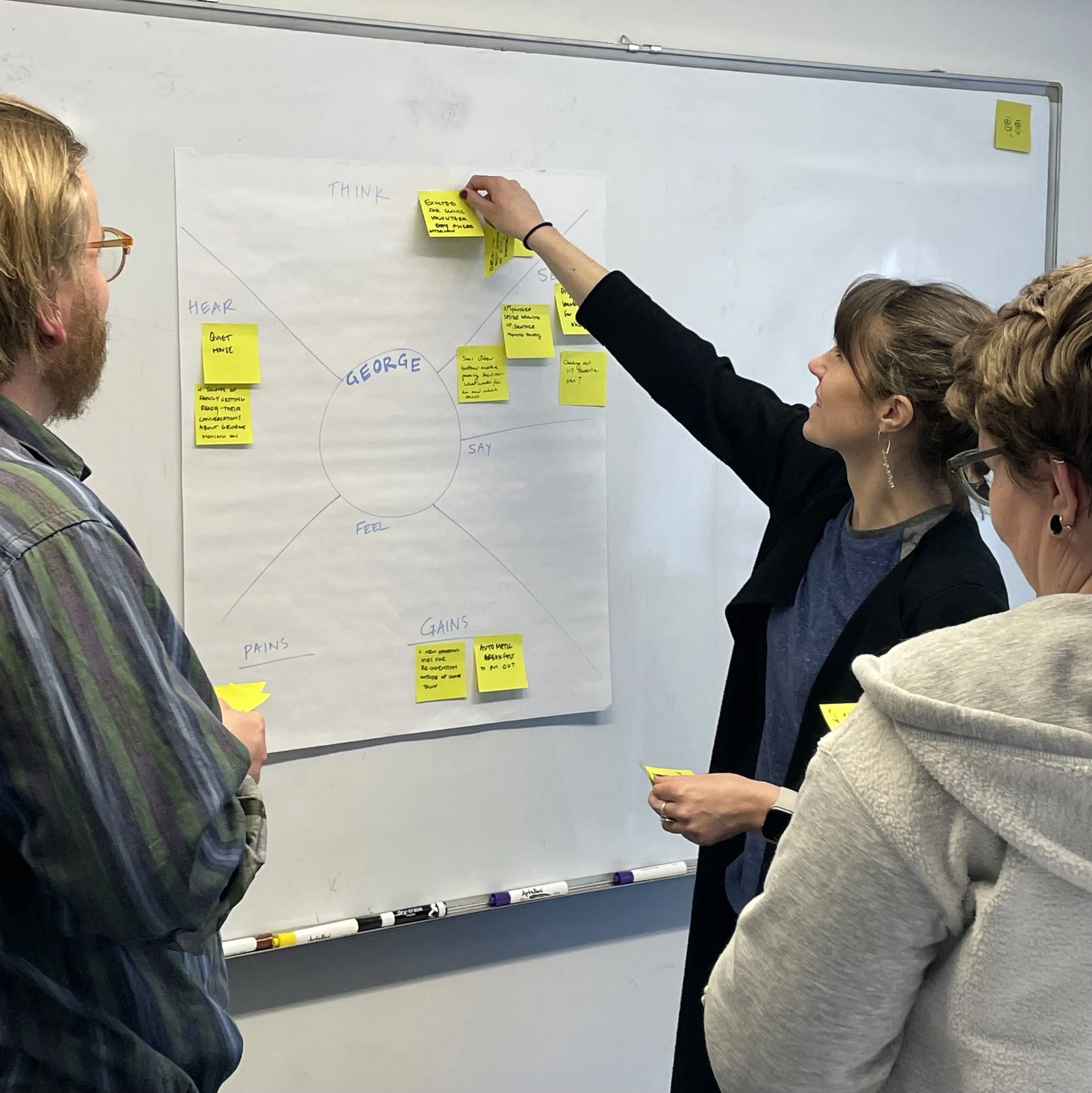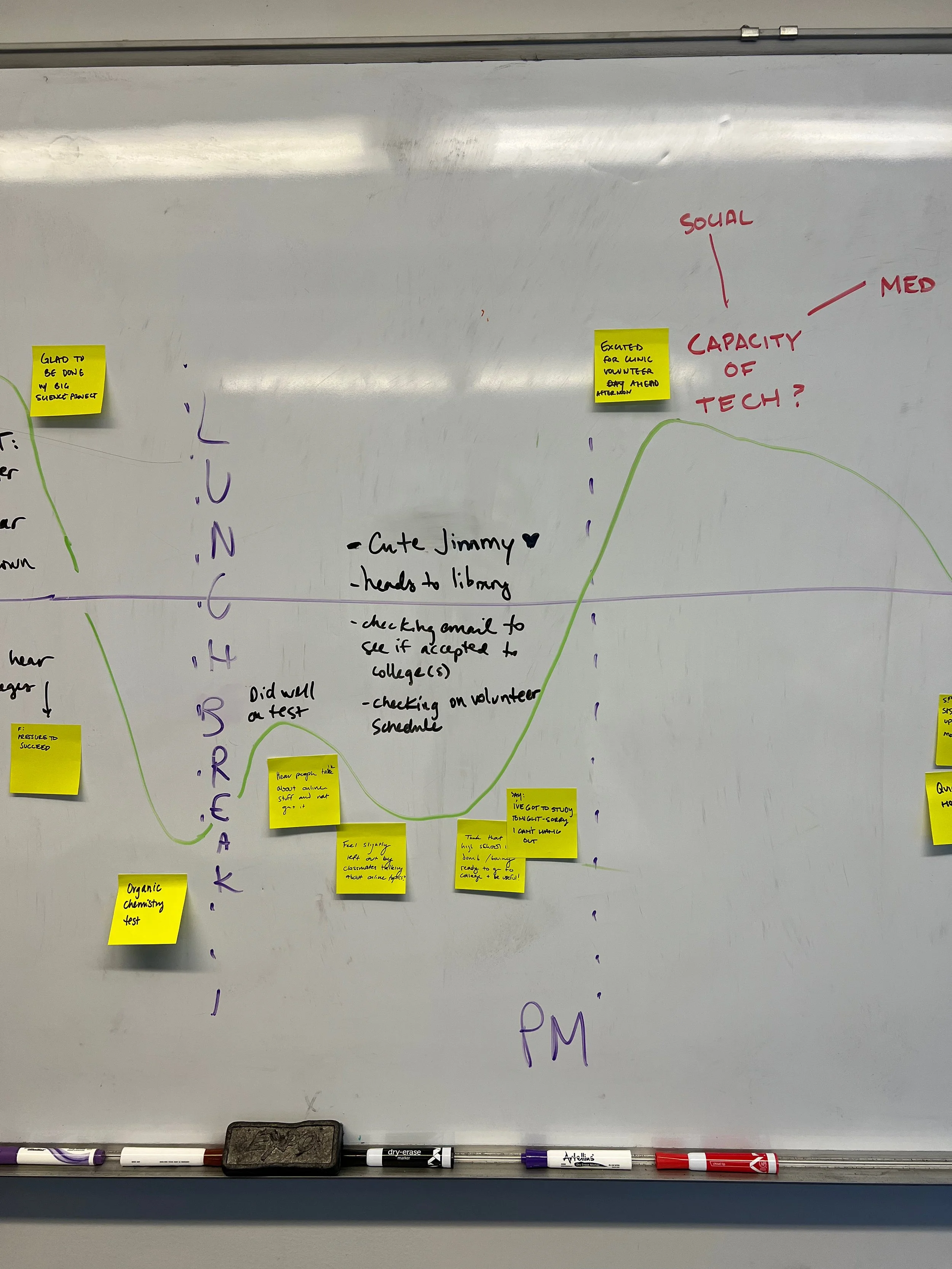George’s Decision
In “George’s Decision,” our team was tasked with developing user personas around a speculative future in which every person gets to choose at age 18 how much of their data will remain private. In making decisions to guide this project, we prioritized developing identities steeped in complexity and realistic relationships to technology in order to create the most opportunities for a wide variety of design teams to find generative possibilities for their own work.
Contributor Case Study
Participants: Molly McLain, Austin Roch, Charlie Wilcox
April 2023
PNCA Collaborative Design/Design Systems
Project At A Glance
Deliverable: Persona and surrounding assets for future-casting workshops
Context: Persona exists thirty years in the future, in a world where every person at the age of 18 can choose how private their personal data will be for the remainder of their lives.
Goal: To depict a realistic identity who has complex relationships to technology and the world around them that will provide multiple inflection points into their upcoming decision.
Values: thorough intellectual inquiry, capacity for complexity, balance of information, social awareness
In April 2021, a new software update rolled out to Apple iPhones that lets users elect to not let apps track their data outside of the app, a move that sent numerous tech giants into a frenzy, foremost among them Facebook. Apple may have done this for the sake of user security, or may have done it as a move of corporate sabotage against their competitors, and even the efficacy of the command could be questioned, but it remains clear that the update escalated debates about our own agency in choosing our own level of digital privacy.
It is with this in mind that our team was tasked by a prominent think tank to craft the assets for a series of future-casting workshops involving decision-making and digital privacy. In the speculative future thirty years from now that would become our imaginative space, every person is given a ‘reasonable right to privacy’ during their childhood and then given the option at age 18 to declare to what extent that privacy will extend into their adulthood. Our role is to craft a rousing, realized persona of the type of person who will be facing this decision, in this case a soon-to-be adult woman named George, and provide enough materials for the workshops to develop prospective product and service interventions into George’s Decision without crafting so detailed a vision that the workshoppers have no room to work themselves.
Background
Development
In our follow-up workshop, we successfully honed this persona, first by developing an empathy map based on the personality traits we already established to deduce what this George would see, hear, feel, and think on an average day as they approach their eighteenth birthday and their decision. Once again, we intuitively focused on the emotional realities of George’s day rather than the logistical and tactile elements of living in 2053, believing those emotional inflections to be more resonant to future workshops than dictating the ways in which this future has shifted from our present. After sharing these elements of George’s day on the empathy map, we moved to organize them on a user journey map, so we could give a defined shape to George’s day and find both the highs (getting into a top-choice college!) and lows (feeling excluded from her classmates during lunch!) of her experience as a high performing high school student with many life choices looming. Talking through the narrative of this day gave our team lead the material needed to assemble the final presentation for our client.
In preparation for our collaborative work to develop these personas, we conducted desk research that helped to align our possible lines of inquiry into an overlapping field. With a future-casting project like this, it was important to establish a few boundaries to help us consolidate our ideas and remove some of the least conducive ideas from the furthest reaches of the futures cone. This tethered our work to conceptions of the future that trended closer to our reality in the 2020s, which we believe to be beneficial to preparing materials like this that allow the next team to fully take advantage of the imaginative possibilities within the personas and narratives we frame.
We came together in an initial workshop to craft a variety of personas that we could take back to our client. After first discussing some of the questions we had about the basic realities of the future we were working in, we generated a number of potential traits of our George personas in individual ideation sessions. Upon sharing our ideas, we quickly ignited chain reactions of potential character combinations and engaged in vigorous discussions about the internal logics of these identities.
In crafting these personas, it became clear to us that the most important question to answer is how each respective George relates to technology: are they avoidant of technology, an early adopter, or somewhere in the middle, where they perhaps cordon off some aspects of their lives from being tech-oriented and embrace it in other areas? The answer to this question could directly indicate how primed the Georges are to release their private data. Unlocking this throughline allowed us to categorize some of the other ideas we had developed in this workshop and align them with the quickly forming personas. We entered a very productive space where we could debate and interrogate the potential reasonings why someone, for example, would be tech-agnostic in this futuristic high school (“did bad experiences push them away? Do good ‘offline’ experiences and thirty additional years of coexisting with online technologies give them a significantly different perspective?”) Working efficiently towards these core questions in our initial workshop established a strong baseline of success moving forward as we refined our persona.
Refinement
conclusion
In developing this George persona and a collection of assets surrounding her, our team demonstrated some of the core values that we uphold in all of our work. We have pursued a thorough intellectual inquiry into the possibilities of this future space, and maintained a superb capacity for complexity in the identities and situations we crafted, and maintained balance between developing detail and leaving space for subsequent teams to design. Lastly, we strove for social awareness in the opportunities we built into our persona, aiming to create a design space that would encourage thoughtful interrogation into what could better inform our George’s decision. These are the traits that we are excited to bring to more prospective clients and speculative projects in the future.
Concept Meeting
In collaboration with our client, we zeroed in on the persona that fit into the midrange of tech affinity, which clearly gave us the most room to build opportunities for further future-casting. This George (George 1, above), has highly defined reasons in her life that makes it understandable why she would be willing to cede privacy for the benefits of tech access; specifically, this comes from her mother, who we have constructed to have a health condition that is monitored through a tool that tracks her biometrics at all times. This George can therefore see the benefits of reduced privacy in her own home. Alongside this, however, we constructed this George as, partially as a result of her mother’s condition, to be a bit more reserved, dedicated to her family, and less oriented to a wide net of social connections. In this way she sees less need to cede privacy for the management of social connections, in the way we may connect to joining social media in today’s world. These two aspects balance each other, her interest in science and her mother’s health issue providing a potential ‘wedge’ to open up her disinterest in other aspects of data access.















